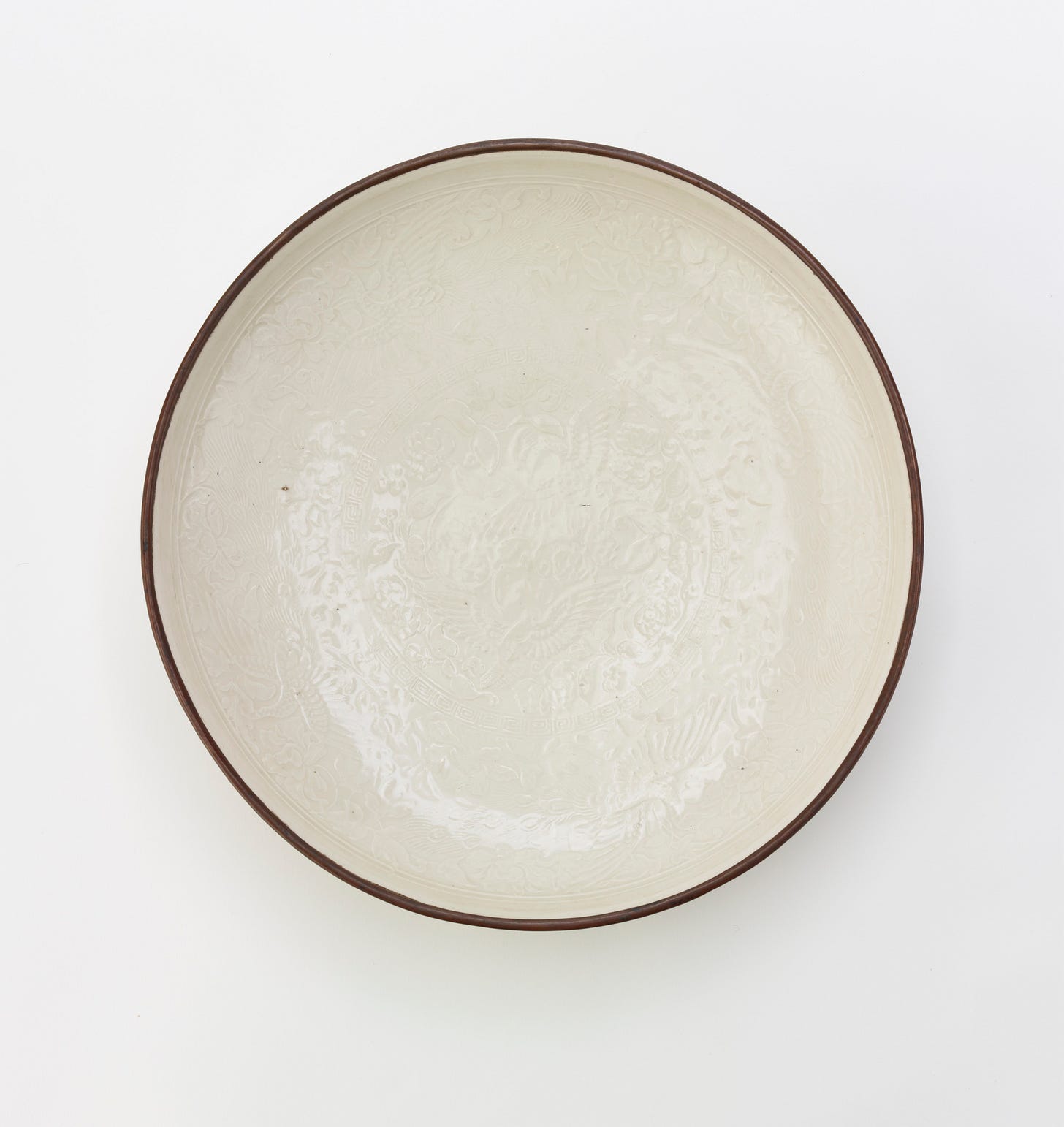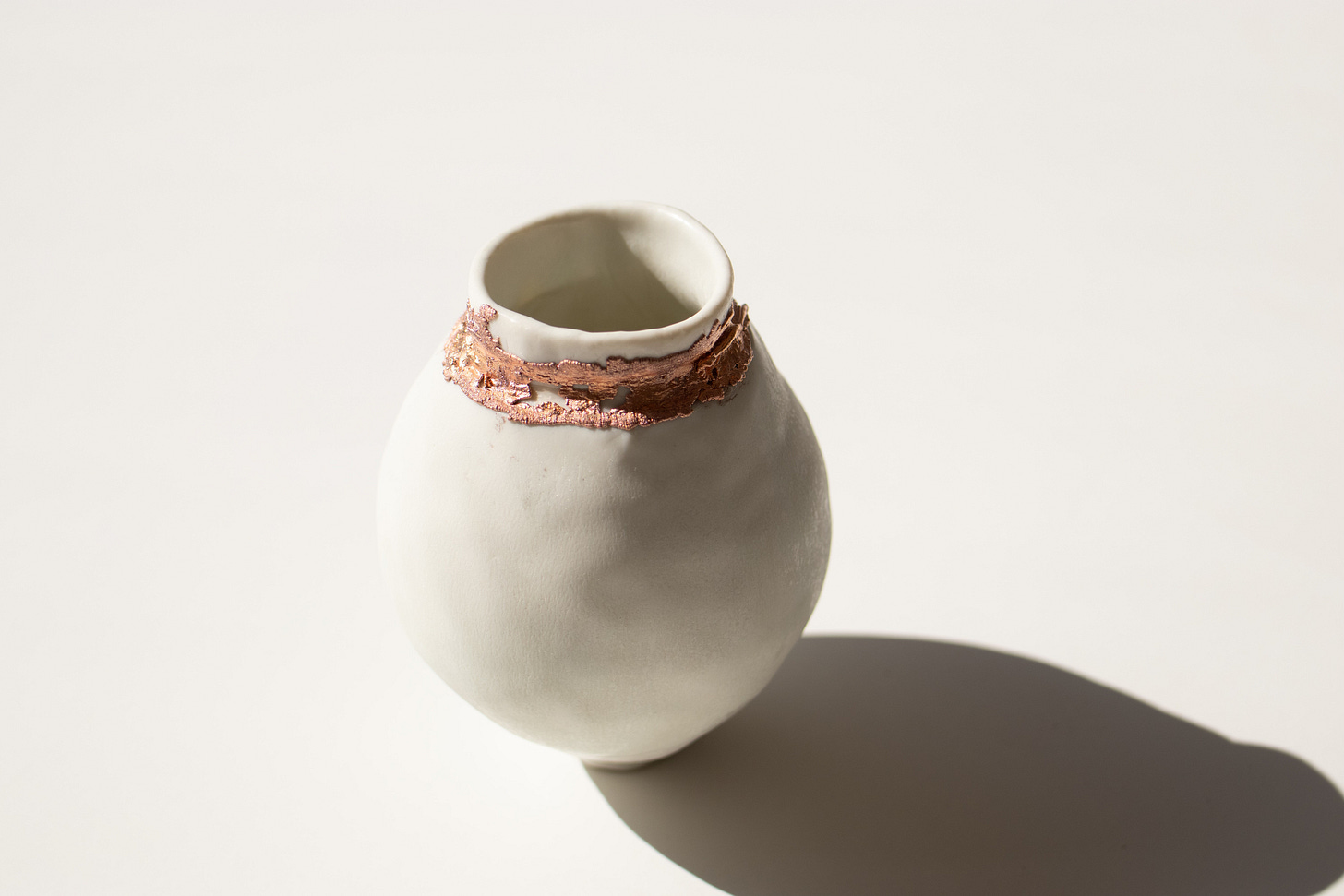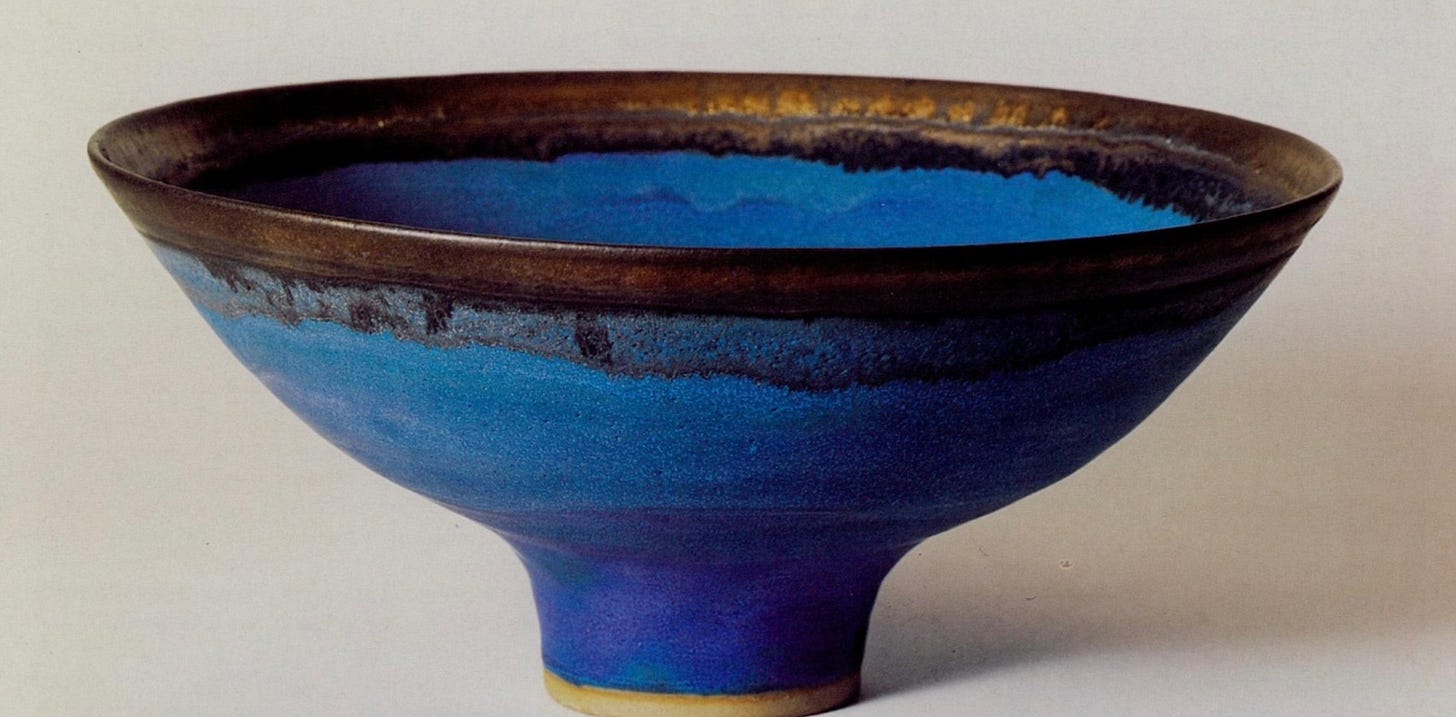During the last year, I’ve been experimenting with combining metals and ceramics. I looked for ways to incorporate metal prior to and after the firing. I didn’t want the metal to be glued or brushed on like a lustre: I wanted to understand how these materials could fuse together, even though they often have different melting points.
The research has taken an interesting turn and some of this work will be exhibited in London in August (details to follow). Metal can be incorporated into ceramics with high temperature wire (the familiar wire that is used to make hanging ceramic ornaments), it can be incorporated into the clay body in tiny particles, it can be brushed onto the piece in the form of lustre, and it can be fused onto a water-tight piece via the process of electroforming.
The discovery of electroforming has opened up a lot of possibilities for my practice. Electroforming relies on electricity to move particles of copper from plates to another object, which has been properly prepared and brushed with a copper wash. The process involves the use of anode and cathode to transfer ions from copper plates onto a finished piece, where it will react with the electrons of the copper wash.
After a few tests with smaller pieces of porcelain, some of which I made into pendants and earrings, I tested with a porcelain vase which I had purposefully left unglazed at the rim.
As I cleaned up the piece from the solution it had been immersed in for hours, I interrogated my fascination with the interaction between metal and ceramics. If I was so obsessed with this that I dedicated months to test out various options, surely a lot of other people before me would have been too.
I didn’t know then that by gilding the rim of a vase with a layer of copper, I was echoing an ancient Chinese tradition.
The relationship between metal and ceramics
The word “skeuomorphism” is used to describe the crafting of an object to resemble its inspiration. While the word “skeuomorph” is now often used in connection with interface design (for instance, notepad phone applications that are made to look like physical notepads), the archaeologist Goldron Childe defined it in 1956 as a method of production which gives us “a glimpse into productive activities and artistic media of which no direct evidence survives.”1 When it comes to ceramic vessels, the term is used to describe “the manufacture of vessels in one material intended to evoke the appearance of vessels regularly made in another”2
Ceramic vessels often imitated metal ones, as the latter were more expensive to produce and could not be made in large amounts. Due to the fact that metal vessels and containers were valuable, they would often be melted to recoup the bouillon value of the metal, which is one of the reasons why we haven’t found nearly as many compared to ceramic ones. 3
There are numerous examples of metal to ceramic skeuomorphism. Many vessels from Bronze Age Minoan Crete were copies of metal ones4. Unlike when baskets were used as moulds for ceramic vessels, on which one can clearly see the tangible sign of the original, metal-inspired ceramic pieces were not made from a metal mould: they were mimicking precious vessels that were usually reserved for the upper classes5. It is very interesting to think about the role of these pieces. Much like current luxury bag reproductions, they were meant to give their users a taste of what it was like to be part of that world.
In other cases, the metal was added to a finished ceramic piece, much like I have been doing for my vases, to make the piece more precious. This was the case of some ancient Chinese ceramics.
Ding wares
Ding wares were high-fired porcelains produced in China starting during the Tan Dynasty (618-907) and peaking during the Song dynasty during the 10th and 11th century AD and until the 13th century. The centers of production were mostly in north China in the Quyang county of the Hebei Province, with the main kiln located in the Jianzi village, then known as Dingzhou (hence the name “Ding ware”)6 . Ding wares were selected to be used at court by the royal family and were very popular7.
They were fired in coal-fueled kilns that reached temperatures of around 1280-1350C8. The oxidation atmosphere gave the porcelain a warm ivory hue, which was in favor at the time. Most of the pieces were wheel thrown and then carved by hand, although starting in the 12th century, they were made using moulds that had already been carved9. One of the reasons behind this shift was that Ding wares were often made to imitate vessels made of gold and silver10.
Analysis conducted on the clay body of archeological findings indicated that the clay used contained high levels of alumina (above 25%)11.
The striking feature of Ding wares, however, is their rim, which was often banded with metal.

There is considerable debate as to whether the banded rim was a result of the way the wares were fired - upside down in the kiln, necessitating for the rim to be unglazed - or whether the decision to leave the rim unglazed was deliberate so that metal could then be applied. It appears as if the metal banding was indeed popular at the time, suggesting that the application of metal was not so much a necessity to cover a raw rim, but rather a deliberate choice in line with the taste at court12.
The practice of adding metal to the rims was highly specialized and it was not new: golden rims were applied to silver vessels from the 6th century and the addition of metal to the rims and feet of ceramic pieces became established from the 9th century AD and continued well into the 14th century13.
There are stunning examples of Ru wares (rare stoneware pieces with beautiful crackled celadon glazes) featuring metal rims14.

Metal rims were so popular that in 1036 a decree was issued whereby “all utensils...only officials of the third grade and above could use wares decorated with gold bands...or, only if the ware was a gift from the Emperor.”15

Kiln stacking
The way Ding porcelains were fired deserves mentioning. The wares were fired upside down, which avoided distortions to the shape and also necessitated for the rims to be left raw. Pieces were not loaded in the kiln individually, rather they were first loaded in L-shape step setters: a container with a series of steps on which bowls of increasing circumference were placed rim down16. The setters allowed for the firing of many pieces at once and various setters existed for different shapes of wares17.
While Ding wares were prized ancient pieces for the royal court, the fascination with metal rims and gilded embellishments remains to this day. In searching for modern interpretations of the style, I saw this beautiful 1983 vessel by Lucie Rie, with a brown metallic edge18.
Metallic glazes (which are essentially oxide washes with manganese and iron), are used to decorate parts of a vessel. The washes are often very runny and need to be applied quite thick, making it challenging to control them. Their behavior can also be used to accentuate a shape, like I did in one of my recent vases for the 274 moons/274 vases project.
Conclusion
Metal and clay have had a close relationship for centuries. Clay was used to create imitations of metal vessels and metal in turn was used to embellish ceramic pieces that were meant for royalty. The look of metal can be imitated by creating oxide washes and the invention of lustre has opened more options for bringing these two elements together.
My personal fascination comes from the fact that metals are present in clay, even in small amounts. Metal and clay are often found together. Iron, copper, nickel are all used to enhance glazes. Yet, these materials are often seen as distinct. We add metal to decorate a ceramic piece as if the metal was distinct and other, whereas metals are and have always been part of the ceramic process.
Bibliography
“Scientific and technological insights on ancient Chinese pottery and porcelain : proceedings of the International Conference on Ancient Chinese Pottery and Porcelain held in Shanghai from November 1 to 5, 1982”, ed. by Shanghai Institute of Ceramics, Academia Sinica
Alan Caiger-Smith, “Lustre Pottery: Technique, tradition and innovation in Islam and the Western World”, Herbert Press Ltd, 1985
Carl Knappett, Photographs, Skeuomorphs And Marionettes: Some thoughts on mind, agency and object, in “Journal of material culture”, Vol 7(1) 2002
Gordon V. Childe, “Piecing together the past”, Routledge and Kegan Paul; London; 1956
Lucie Rie: 1902-1995, in “Ceramic review”, 154-1999, p.11
Jianfeng Cuia, Nigel Wood, Dashu Qin, Lijun Zhoua, Mikyung Koa, Xin Li, Chemical analysis of white porcelains from the Ding Kiln site, Hebei Province, China, “Journal of Archaeological Science” 39 (2012)
Joseph Needham, Nigel Wood, Rose Kerr, Ts'ai Mei-Fen, Zhang Fukang, “Chemistry and chemical technology. Volume 5, part 12 Ceramic technology”, 2004, Cambridge University Press
Rose Kerr, “Song Dynasty Ceramics”, V&A Publications
Song Xiaoyan, Ding Ware, as White as Snow and as Lustrous as Jade, http://www.chinatoday.com.cn/ctenglish/2018/ich/201805/t20180515_800129487.html
Suzanne G. Valenstein, “A handbook of Chinese Ceramics”, The Metropolitan Museum of Art, New York, 1989
Ts'ai Mei-fen, A Discussion of Ting Ware with Unglazed Rims and Related Twelfth-Century Official Porcelain, “Arts of the Sung and Yüan”, Edited by Maxwell K. Hearn and Judith G. Smith, Department of Asian Art, The Metropolitan Museum of Art, 1996
Vickers, Michael J., “Pots and pans : a Colloquium on Precious Metals and Ceramics in the Muslim, Chinese and Graeco-Roman Worlds”, Oxford 1986
Vickers, Michael J., “Artful crafts : ancient Greek silverware and pottery”, Oxford : Clarendon Press, 1996
Where you can find me or my work this month
Read my new diary entries for my 274 moons / 274 vases projects. I am making one vase for each one of Saturn’s moons and keeping a diary for each vase as I make it. Finished vases are also released to the public. Catch up on the project and diary entries here.
Upcoming exhibitions
My work will be exhibited in London in August and in Paris in September. More details and dates to follow soon!
Gordon V. Childe, “Piecing together the past”, Routledge and Kegan Paul; London; 1956, p.13
Vickers, Michael J., “Artful crafts : ancient Greek silverware and pottery”, Oxford : Clarendon Press, 1996, p.106
See Vickers, Michael J., “Pots and pans : a Colloquium on Precious Metals and Ceramics in the Muslim, Chinese and Graeco-Roman Worlds”, Oxford 1986
Carl Knappett, Photographs, Skeuomorphs And Marionettes: Some thoughts on mind, agency and object, in “Journal of material culture”, Vol 7(1) 2002, p.109
ibid, pp.110-112
Song Xiaoyan, Ding Ware, as White as Snow and as Lustrous as Jade, http://www.chinatoday.com.cn/ctenglish/2018/ich/201805/t20180515_800129487.html
ibid
Rose Kerr, “Song Dynasty Ceramics”, V&A Publications, p.44
ibid, p.49
ibid
Jianfeng Cuia, Nigel Wood, Dashu Qin, Lijun Zhoua, Mikyung Koa, Xin Li, Chemical analysis of white porcelains from the Ding Kiln site, Hebei Province, China, “Journal of Archaeological Science” 39 (2012), p.820
Ts'ai Mei-fen, A Discussion of Ting Ware with Unglazed Rims and Related Twelfth-Century Official Porcelain, “Arts of the Sung and Yüan”, Edited by Maxwell K. Hearn and Judith G. Smith, Department of Asian Art, The Metropolitan Museum of Art, 1996, p.111-112
Joseph Needham, Nigel Wood, Rose Kerr, Ts'ai Mei-Fen, Zhang Fukang, “Chemistry and chemical technology. Volume 5, part 12 Ceramic technology”, 2004, Cambridge University Press, p.696
Rose Kerr, p.29
cited in Ts'ai Mei-fen, p.112
See “Scientific and technological insights on ancient Chinese pottery and porcelain : proceedings of the International Conference on Ancient Chinese Pottery and Porcelain held in Shanghai from November 1 to 5, 1982”, ed. by Shanghai Institute of Ceramics, Academia Sinica; and Joseph Needham et al, pp.346-348
“Scientific and technological insights on ancient Chinese pottery and porcelain : proceedings of the International Conference on Ancient Chinese Pottery and Porcelain held in Shanghai from November 1 to 5, 1982”, ed. by Shanghai Institute of Ceramics, Academia Sinica, p.283-284
Lucie Rie: 1902-1995, in “Ceramic review”, 154-1999, p.11






